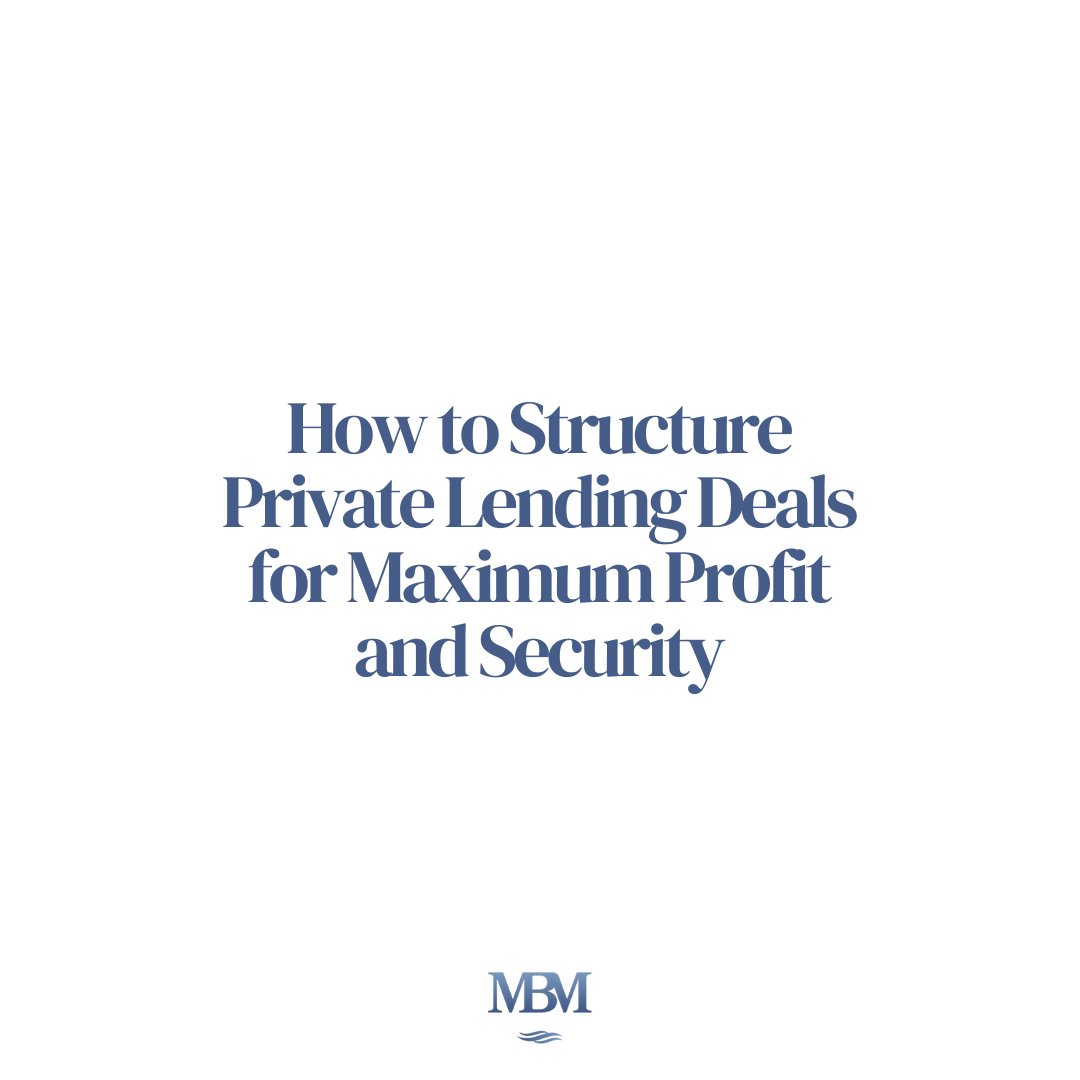Private real estate lending is an excellent way to generate passive income and build wealth, but the key to long-term success lies in how you structure your deals. A well-structured loan ensures that you maximize your returns while protecting your capital.
Many new lenders make the mistake of focusing only on interest rates without considering loan terms, collateral, or exit strategies. A poorly structured deal can expose you to unnecessary risk, delayed repayments, or even losses in the event of borrower default.
This guide will show you how to structure private lending deals for both profitability and security. You’ll learn how to set loan terms, determine interest rates, protect yourself with proper collateral, and ensure you get paid on time.
How to Create a Bulletproof Private Lending Agreement: The Key Clauses You Need
Setting the Right Loan Amount
Before offering a loan, you need to determine the correct loan-to-value (LTV) ratio and the total loan amount.
Why Loan Amount Matters
- A loan that’s too high increases your risk if the borrower defaults.
- A loan that’s too low may leave you with lower returns than expected.
Loan-to-Value (LTV) Ratio Guidelines
The LTV ratio compares the loan amount to the property’s value. A lower LTV reduces your exposure to risk.
Recommended LTV Ratios:
- Fix-and-flip deals: 65-70% of the after-repair value (ARV).
- Buy-and-hold rentals: 70-75% of the property’s current market value.
- Riskier borrowers or projects: Keep LTV below 65%.
Example:
If a borrower wants $100,000 for a property with an ARV of $150,000, the LTV is 67%. This is within the safe lending range for a fix-and-flip loan.
By keeping your LTV within recommended limits, you ensure there’s a buffer if the borrower defaults or market conditions change.
Choosing the Right Interest Rate
Your interest rate determines how much you earn from the loan. It should reflect the risk level, market demand, and borrower experience.
Factors That Affect Interest Rates
- Borrower’s Experience: More experienced investors can get lower rates.
- Market Conditions: Competitive lending markets require more flexible rates.
- Loan Term: Shorter-term loans often have higher interest rates.
Typical Interest Rates for Private Loans
- Fix-and-flip loans: 8-12% interest.
- Rental property loans: 6-10% interest.
- Riskier loans: 12-15% interest.
Example:
A borrower with a strong track record might secure a 10% interest rate on a $100,000 loan, earning you $10,000 per year in passive income.
By setting an interest rate that reflects the deal’s risk and market conditions, you ensure steady returns while remaining competitive.
Structuring Loan Terms for Profitability
The length and structure of your loan directly impact how and when you get paid.
Typical Private Lending Loan Terms
- Short-term (6-12 months): Common for fix-and-flip projects.
- Mid-term (1-3 years): Used for value-add rental properties.
- Long-term (5-10 years): Best for stabilized rental properties.
Key Loan Term Considerations
- Amortization vs. Interest-Only Loans
- Interest-Only Loans: Borrowers make only interest payments during the loan term, with the principal due at the end. This provides steady passive income and a large payout when the loan matures.
- Amortized Loans: Borrowers pay both principal and interest over time, gradually reducing the loan balance.
- Balloon Payments
- A balloon payment means the full loan amount is due at the end of the term. This works well for fix-and-flip investors who plan to repay you after selling the property.
- Prepayment Penalties
- Some borrowers may pay off the loan early, cutting into your expected interest earnings. Including a prepayment penalty ensures you get a minimum return even if the loan is paid off early.
Example Loan Structure:
- Loan Amount: $100,000
- Interest Rate: 10%
- Term: 12 months
- Payments: Interest-only, $833/month
- Balloon Payment: $100,000 due at the end of the term
- Prepayment Penalty: 3 months’ interest if paid off early
This structure ensures you earn steady monthly income while protecting your total return.
Securing Your Loan with Collateral
The biggest mistake new lenders make is failing to properly secure their loan. If a borrower defaults, you need a legal claim to the property to recover your investment.
Steps to Secure Your Loan
- Record a Mortgage or Deed of Trust
- This places a legal claim on the property, ensuring you’re repaid first if it’s sold
.
- Get a Personal Guarantee (if applicable)
- In some cases, a borrower may personally guarantee the loan, making them legally responsible even if the project fails.
- Check for Other Liens
- Ensure your lien position is first priority, meaning you get paid before any other lenders in case of foreclosure.
- Title Insurance
- Protects you from legal disputes over property ownership.
By securing your loan properly, you eliminate unnecessary risk and guarantee repayment protection.
Setting Up a Repayment Plan
The repayment schedule determines when and how you receive payments. Structuring it correctly ensures consistent cash flow and prevents late payments.
Common Repayment Structures
- Monthly Interest-Only Payments: Ensures steady passive income.
- Quarterly Interest Payments: Works for borrowers who prefer larger but less frequent payments.
- Lump-Sum Payments at Loan Maturity: Used when the borrower plans to repay after selling or refinancing the property.
Late Payment Protections
- Late Fees: A 5-10% penalty on missed payments discourages late payments.
- Default Interest Rate: If a borrower is late, the interest rate increases, adding extra protection.
A well-structured repayment plan protects your cash flow and ensures borrowers stay accountable.
Ensuring a Clear Exit Strategy
Every private lending deal should have a defined exit strategy to ensure repayment. The borrower must show how they’ll pay off the loan when the term ends.
Common Exit Strategies
- Selling the Property (Fix-and-Flip Investors)
- The borrower renovates and sells for a profit, using the proceeds to repay the loan.
- Refinancing into a Traditional Loan (Buy-and-Hold Investors)
- The borrower improves the property’s value, qualifies for a long-term mortgage, and repays your loan.
- Rental Income (Long-Term Investors)
- If the property generates strong rental income, the borrower may use cash flow to pay you back.
Before funding a deal, always ask the borrower what their exit strategy is and ensure it’s realistic.
The Complete Guide to Fix-and-Flip Loans: What Every Real Estate Investor Needs to Know
Conclusion: How to Structure Private Lending Deals for Maximum Profit and Security
Structuring private lending deals correctly is the key to maximizing profits and reducing risk. By setting the right loan amount, interest rate, terms, and collateral protections, you ensure that every deal is both profitable and secure.
The best private lenders don’t just fund deals—they structure them strategically to ensure steady returns and long-term success.
Want to learn how to create bulletproof lending deals and grow your portfolio? Visit The MicroBanking Method to master private lending and build sustainable wealth through real estate lending.




